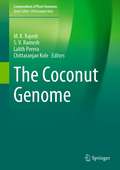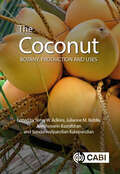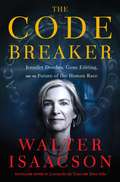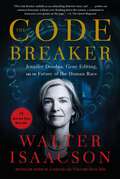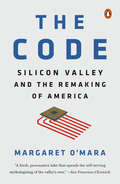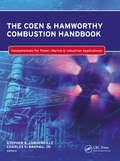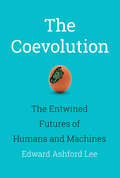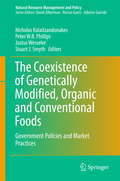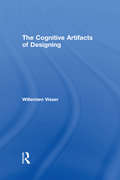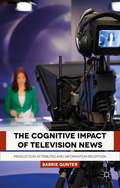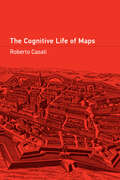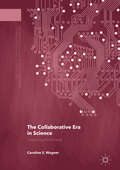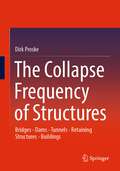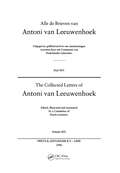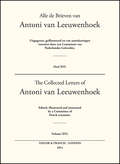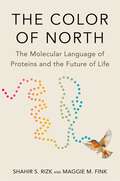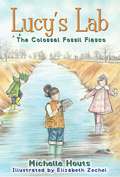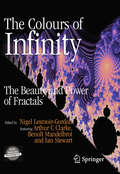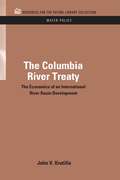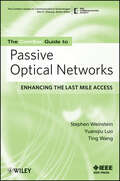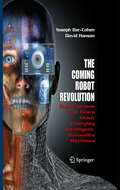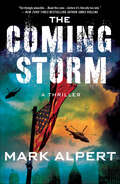- Table View
- List View
The Coconut Genome (Compendium of Plant Genomes)
by Chittaranjan Kole M. K. Rajesh S. V. Ramesh Lalith PereraThis book serves as the first comprehensive compilation describing the breeding strategies and genetics and genomics of the coconut palm. It describes gene evolution of economically important traits such as oil biosynthesis, aroma and fragrance, disease-resistant genes and small RNAs-mediated gene regulation of coconut. Application of “omics” approaches in palms and the prospects of genome editing technologies in coconut are also discussed. The author list includes pioneers and experts in the field of coconut genomics. The book appeals to postgraduate students, researchers and industry players in the field of plantation crops in general and coconut in particular.
The Coconut: Botany, Production and Uses (Botany, Production and Uses)
by K. Chapman Q. T. Nguyen S. Rajkumar C. Yang R. Cave S. V. Ramesh C. Oropeza E. A. Aguilar J. Alouw F. C. Beveridge M. A. Bezerra R. Bhat R. Dakshayani F. M. Dayrit P. D. Dissanayake H. R. Gheyi K. B. Hebbar V. B. Johnson Sundaravelpandian Kalaipandian S. Karouw A. C. Khanashyam E.Y.Y. Kong C.F.D. Lacerda J. C. Lacsina M. R. Manikantan E. C. Manohar Z. Mu M. Narváez M. F. Neto C. F. Ortiz R. Pandiselvam B. Panis A. Peña L. Perera S. Periasamy M. Ramaswamy E. Ramos N. Satyaseelan C. Silverio S. Sisunandar P. Subramanian P. A. Sukumar R. S. Veluchamy V.R.M. Vidhanaarachchi H. WilmsThe coconut palm (Cocos nucifera L.) is one of the world's most important palms, and contributes significantly to the income and livelihood of many people in tropical countries. Widely referred to as the 'tree of life', coconut has been used as a source of food, drink, oil, medicine, shelter and wood for around 500 years. Every part of the coconut palm can be utilized. The demand for coconut fruit and its products has increased recently as people have become aware of its nutritional and health benefits, especially those of coconut water and virgin coconut oil. This book covers all aspects of coconut including origins and diversity; ecophysiology; production in a changing climate; pests and diseases; harvest and postharvest management; breeding and genetics; as well as the current and future status of coconut as an economic crop. This book is a key resource for researchers and students in horticulture, plant science and agriculture, and those interested in the production of tropical crops, and practitioners in the coconut industry.
The Code Breaker: Jennifer Doudna, Gene Editing, and the Future of the Human Race
by Walter IsaacsonThe bestselling author of Leonardo da Vinci and Steve Jobs returns with a gripping account of how the pioneering scientist Jennifer Doudna, along with her colleagues and rivals, launched a revolution that will allow us to cure diseases, fend off viruses, and enhance our children. In the spring of 2012, the Berkeley biochemist Jennifer Doudna and her collaborators turned a curiosity of nature into an invention that will transform the future of the human race: an easy-to-use tool that can edit DNA. Known as CRISPR, it opened a brave new world of medical miracles and moral questions. It has already been deployed to cure deadly diseases, fight the coronavirus pandemic of 2020, and make inheritable changes in the genes of babies. The development of CRISPR and the war against coronavirus will hasten our transition to the next great innovation revolution. The past half-century has been an information-technology era, based on the microchip, the computer, and the internet. Now we are entering an even more momentous era, a life-science revolution. Children who study digital coding will be surpassed by those who study the code of life. Should we use our new evolution-hacking powers to make us less susceptible to viruses and eliminate dreaded disorders? What a wonderful boon that would be! Right? And what about preventing congenital deafness or blindness? Or being very short? Or being depressed? Hmmm…How should we think about that? Should we allow parents, if they can afford it, to enhance the IQ or height or memory or muscles of their kids? After helping to discover CRISPR, Doudna became a leader in wrestling with these moral and policy issues. Her life story illustrates that the key to innovation is connecting basic science to our everyday lives—moving discoveries from our labs to our bedsides—in ways that respect our moral values. It&’s a thrilling detective tale that involves the most profound wonders of nature, from the origins of life to the future of our species.
The Code Breaker: Jennifer Doudna, Gene Editing, and the Future of the Human Race
by Walter IsaacsonThe bestselling author of Leonardo da Vinci and Steve Jobs returns with a gripping account of how Nobel Prize winner Jennifer Doudna and her colleagues launched a revolution that will allow us to cure diseases, fend off viruses, and have healthier babies. <P><P>When Jennifer Doudna was in sixth grade, she came home one day to find that her dad had left a paperback titled The Double Helix on her bed. She put it aside, thinking it was one of those detective tales she loved. When she read it on a rainy Saturday, she discovered she was right, in a way. As she sped through the pages, she became enthralled by the intense drama behind the competition to discover the code of life. Even though her high school counselor told her girls didn’t become scientists, she decided she would. <P><P>Driven by a passion to understand how nature works and to turn discoveries into inventions, she would help to make what the book’s author, James Watson, told her was the most important biological advance since his co-discovery of the structure of DNA. She and her collaborators turned a curiosity of nature into an invention that will transform the human race: an easy-to-use tool that can edit DNA. Known as CRISPR, it opened a brave new world of medical miracles and moral questions. The development of CRISPR and the race to create vaccines for coronavirus will hasten our transition to the next great innovation revolution. The past half-century has been a digital age, based on the microchip, computer, and internet. Now we are entering a life-science revolution. Children who study digital coding will be joined by those who study genetic code. Should we use our new evolution-hacking powers to make us less susceptible to viruses? What a wonderful boon that would be! And what about preventing depression? Hmmm…Should we allow parents, if they can afford it, to enhance the height or muscles or IQ of their kids? <P><P> After helping to discover CRISPR, Doudna became a leader in wrestling with these moral issues and, with her collaborator Emmanuelle Charpentier, won the Nobel Prize in 2020. Her story is a thrilling detective tale that involves the most profound wonders of nature, from the origins of life to the future of our species. <P><P><b>A New York Times Bestseller</b>
The Code: Silicon Valley and the Remaking of America
by Margaret O'MaraThe true, behind-the-scenes history of the people who built Silicon Valley and shaped Big Tech in America <P><P>Long before Margaret O'Mara became one of our most consequential historians of the American-led digital revolution, she worked in the White House of Bill Clinton and Al Gore in the earliest days of the commercial Internet. There she saw first-hand how deeply intertwined Silicon Valley was with the federal government, and always had been, and how shallow the common understanding of the secrets of the Valley's success actually was. Now, after almost five years of pioneering research, O'Mara has produced the definitive history of Silicon Valley for our time, the story of mavericks and visionaries, but also of powerful institutions creating the framework for innovation, from the Pentagon to Stanford University. It is also a story of a community that started off remarkably homogeneous and elitist and stayed that way, and whose belief in its own mythology has deepened into a collective hubris that has led to astonishing triumphs as well as devastating second-order effects. <P><P>Deploying a wonderfully rich and diverse cast of protagonists, from the justly famous to the unjustly obscure, across four generations of explosive growth in the Valley, from the Forties to the present, O'Mara has wrestled into magnificent narrative form one of the most fateful developments in modern American history. She is on the ground with all of the key tech companies, and chronicles the evolution in their offerings through each successive era, and she has a profound fingertip feel for the politics of the sector, and its relation to the larger cultural narrative about tech as it has evolved over the years. <P><P> Perhaps most impressively, O'Mara has penetrated the inner kingdom of tech venture capital firms, the insular and still remarkably old-boy world that became the cockpit of American capitalism and the crucible for bringing technological innovation to market, or not. The transformation of big tech into the engine room of the American economy and the nexus of so many of our hopes and dreams--and increasingly nightmares--can be understood, in Margaret O'Mara's masterful hands, as the story of one California valley. As her majestic history makes clear, its fate is the fate of us all.
The Coen & Hamworthy Combustion Handbook: Fundamentals for Power, Marine & Industrial Applications (Industrial Combustion)
by Charles E. Baukal Stephen B. LondervilleThe rigorous treatment of combustion can be so complex that the kinetic variables, fluid turbulence factors, luminosity, and other factors cannot be defined well enough to find realistic solutions. Simplifying the processes, The Coen & Hamworthy Combustion Handbook provides practical guidance to help you make informed choices about fuels, burne
The Coevolution: The Entwined Futures of Humans and Machines (The\mit Press Ser.)
by Edward Ashford LeeShould digital technology be viewed as a new life form, sharing our ecosystem and coevolving with us?Are humans defining technology, or is technology defining humans? In this book, Edward Ashford Lee considers the case that we are less in control of the trajectory of technology than we think. It shapes us as much as we shape it, and it may be more defensible to think of technology as the result of a Darwinian coevolution than the result of top-down intelligent design. Richard Dawkins famously said that a chicken is an egg's way of making another egg. Is a human a computer's way of making another computer? To understand this question requires a deep dive into how evolution works, how humans are different from computers, and how the way technology develops resembles the emergence of a new life form on our planet.Lee presents the case for considering digital beings to be living, then offers counterarguments. What we humans do with our minds is more than computation, and what digital systems do—be teleported at the speed of light, backed up, and restored—may never be possible for humans. To believe that we are simply computations, he argues, is a “dataist” faith and scientifically indefensible. Digital beings depend on humans—and humans depend on digital beings. More likely than a planetary wipe-out of humanity is an ongoing, symbiotic coevolution of culture and technology.
The Coexistence of Genetically Modified, Organic and Conventional Foods
by Stuart J. Smyth Nicholas Kalaitzandonakes Peter W. B. Phillips Justus WesselerSince their commercial introduction in 1996, genetically modified (GM) crops have been adopted by farmers around the world at impressive rates. In 2011, 180 million hectares of GM crops were cultivated by more than 15 million farmers in 29 countries. In the next decade, global adoption is expected to grow even faster as the research pipeline for new biotech traits and crops has increased almost fourfold in the last few years. The adoption of GM crops has led to increased productivity, while reducing pesticide use and the emissions of agricultural greenhouse gases, leading to broadly distributed economic benefits across the global food supply chain. Despite the rapid uptake of GM crops, the various social and economic benefits as well as the expanding rate innovation, the use of GM crops remains controversial in parts of the world. Despite the emergence of coexistence between GM, organic and conventional crops as a key policy and practical issue of global scale, there is no coherent literature that addresses it directly. Governments and market stakeholders in many countries are grappling with policy alternatives that settle conflicting property rights, minimize negative market externalities and associated liabilities, maximize the economic benefits of innovation and allow producer and consumer choice. This book intends to fill these needs with contributions from the top theoreticians, legal and economic analysts, policy makers and industry practitioners in the field. As the economics and policy of coexistence start to emerge as an separate subfield in agricultural, environmental and natural resource economics with an increasing number of scholars working on the topic, the book will also provide a comprehensive base in the literature for those entering the area, making it of interest to students, scholars and policy-makers alike.
The Cognitive Artifacts of Designing
by Willemien VisserIn this dynamic review and synthesis of empirical research and theoretical discussion of design as cognitive activity, Willemien Visser reconciles and integrates the classical view of design, as conceptualized by Herbert Simon's symbolic information processing approach, with modern views of design such as the situativity approach, as formulated by Donald Schon. The author goes on to develop her own view on design, in which design is most appropriately characterized as a construction of representations. She lays the groundwork for the integration of design research and cognitive science. This seemingly simple framework has implications that set the stage for this mutually beneficial integration.
The Cognitive Impact of Television News
by Barrie GunterResearch shows that, while people around the world consistently nominate television as their most important news source, much of the content of news bulletins is lost to viewers within moments. In response, Barrie Gunter argues that this can be explained by the way in which televised news is written, packaged and presented.
The Cognitive Life of Maps
by Roberto CasatiThe &“mapness of maps&”—how maps live in interaction with their users, and what this tells us about what they are and how they work.In a sense, maps are temporarily alive for those who design, draw, and use them. They have, for the moment, a cognitive life. To grapple with what this means—to ask how maps can be alive, and what kind of life they have—is to explore the core question of what maps are. And this is what Roberto Casati does in The Cognitive Life of Maps, in the process assembling the conceptual tools for understanding why maps have the power they have, why they are so widely used, and how we use (and misuse) them.Drawing on insights from cognitive science and philosophy of mind, Casati considers the main claims around what maps are and how they work—their specific syntax, peculiar semantics, and pragmatics. He proposes a series of steps that can lead to a precise theory of maps, one that reveals what maps have in common with diagrams, pictures, and texts, and what makes them different. This minimal theory of maps helps us to see maps nested in many cognitive artifacts—clock faces, musical notation, writing, calendars, and numerical series, for instance. It also allows us to tackle the issue of the territorialization of maps—to show how maps can be used to draw specific spatial inferences about territories. From the mechanics of maps used for navigation to the differences and similarities between maps and pictures and models, Casati's ambitious work is a cognitive map in its own right, charting the way to a new understanding of what maps mean.
The Collaborative Era in Science: Governing The Network (Palgrave Advances In The Economics Of Innovation And Technology Ser.)
by Caroline S. WagnerIn recent years a global network of science has emerged as a result of thousands of individual scientists seeking to collaborate with colleagues around the world, creating a network which rises above national systems. The globalization of science is part of the underlying shift in knowledge creation generally: the collaborative era in science. Over the past decade, the growth in the amount of knowledge and the speed at which it is available has created a fundamental shift—where data, information, and knowledge were once scarce resources, they are now abundantly available. Collaboration, openness, customer- or problem-focused research and development, altruism, and reciprocity are notable features of abundance, and they create challenges that economists have not yet studied. This book defines the collaborative era, describes how it came to be, reveals its internal dynamics, and demonstrates how real-world practitioners are changing to take advantage of it. Most importantly, the book lays out a guide for policymakers and entrepreneurs as they shift perspectives to take advantage of the collaborative era in order to create social and economic welfare.
The Collapse Frequency of Structures: Bridges - Dams - Tunnels - Retaining structures - Buildings
by Dirk ProskeThe mathematical verification of the safety of structures can be done by determining the probability of failure or by using safety elements. Observed damages and collapses are usually assessed within the framework of expert reports, which seems reasonable due to the large number of unique structures in the construction industry. However, there should also be an examination of observed safety across all structures. Therefore, in this book the collapse frequencies are determined for different types of structures, such as bridges, dams, tunnels, retaining structures and buildings. The collapse frequency, like the failure probability, belongs to stochasticity. Therefore, the observed mean collapse frequencies and the calculated mean failure probabilities are compared. This comparison shows that the collapse frequencies are usually lower than the calculated failure probabilities. In addition, core damage frequencies and probabilities are given to extend the comparison to another technical product.
The Collected Letters of Antoni Van Leeuwenhoek - Volume 14
by L. C. PalmThis volume (the 14th of a series of 19) contains 21 letters written between August 1701 and March 1704. At least half of these letters were addressed to Fellows of the Royal Society in London. Every volume in the series contains the texts in the original Dutch and an English translation. The great range of subjects studied by Van Leeuwenhoek is reflected in these letters: instruments to measure water; pulmonary diseases; experiments relating to the solution of gold and silver; salt crystals and grains of sand; botanical work, such as duckweed and germination of orange pips; descriptions on protozoa; blood; spermatozoa; and health and hygiene, for example and harmfulness of tea and coffee and the benefits of cleaning teeth.;Volumes One to 13 are available at a reduced price from Swets and Zeitlinger.
The Collected Letters of Antoni Van Leeuwenhoek - Volume 16
by Drs. L. C.In volume XVI of The Collected Letters of Antoni van Leeuwenhoek, 25 letters of Van Leeuwenhoek have been included, all of them written from July 1707 to June 1712. The letters were written to six distinct addressees. The larger part was addressed to the Royal Society in London in general (sixteen letters); and to three of its fellows in particular
The College on the Hill: New History of the Ontario Agricultural College, 1874 to 1999
by Alexander Ross Terry CrowleyHow has the Ontario Agricultural College contributed to Canadian education? What role has the college played in the development of agriculture since it was founded in 1874? This history of Canada’s oldest agricultural college revolves around these two questions. It shows that the college’s mandate has changed in its attempt to serve both education and agriculture. The Ontario Agricultural College was established to enshrine science in farming, but it also became the testing and extension arm of the provincial ministry of agriculture. Direct government control for ninety years provided financial resources not enjoyed by other post-secondary schools, but the results sometimes proved of greater benefit to agriculture than to education or science. Swept into the University of Guelph when it was created in 1964, the college rethought its role. It emerged as a centre for advanced scientific inquiry, for global agricultural programs, and for understanding rural societies. The controversies surrounding these changes and the evolving nature of agriculture and science are brought out fully in this account of the past century and a quarter.
The Colonial Caribbean
by James A. DelleAs a source of colonial wealth and a crucible for global culture, Jamaica has had a profound impact on the formation of the modern world system. From the island’s economic and military importance to the colonial empires it has hosted and the multitude of ways in which diverse people from varied parts of the world have coexisted in and reacted against systems of inequality, Jamaica has long been a major focus of archaeological studies of the colonial period. This volume assembles for the first time the results of nearly three decades of historical archaeology in Jamaica. Scholars present research on maritime and terrestrial archaeological sites, addressing issues such as: the early Spanish period at Seville la Nueva; the development of the first major British settlement at Port royal; the complexities of the sugar and coffee plantation system, and the conditions prior to, and following, the abolition of slavery in Jamaica. The everyday life of African Jamaican people is examined by focusing on the development of Jamaica’s internal marketing system, consumer behavior among enslaved people, iron-working and ceramic-making traditions, and the development of a sovereign Maroon society at Nanny Town. Out of Many, One Peoplepaints a complex and fascinating picture of life in colonial Jamaica, and demonstrates how archaeology has contributed to heritage preservation on the island. Contributors Kofi Agorsah / Douglas V. Armstrong / Maureen J. Brown / Gregory D. Cook / James A. Delle / Marianne Franklin / Jillian E. Galle / Candice Goucher / Mark W. Hauser / Kenneth G. Kelly / Matthew Reeves / Amy Rubenstein-Gottschamer / Robyn P. Woodward
The Color of Food: Stories of Race, Resilience and Farming
by Natasha BowensImagine the typical American farmer. Many people visualize sun-roughened skin, faded overalls, and calloused hands--hands that are usually white. While there's no doubt the growing trend of organic farming and homesteading is changing how the farmer is portrayed in mainstream media, farmers of color are still largely left out of the picture.The Color of Food seeks to rectify this. By recognizing the critical issues that lie at the intersection of race and food, this stunning collection of portraits and stories challenges the status quo of agrarian identity. Author, photographer, and biracial farmer Natasha Bowens's quest to explore her own roots in the soil leads her to unearth a larger story, weaving together the seemingly forgotten history of agriculture for people of color, the issues they face today, and the culture and resilience they bring to food and farming.The Color of Food teaches us that the food and farm movement is about more than buying local and protecting our soil. It is about preserving culture and community, digging deeply into the places we've overlooked, and honoring those who have come before us. Blending storytelling, photography, oral history, and unique insight, these pages remind us that true food sovereignty means a place at the table for everyone.Natasha Bowens is an author, farmer, and creator of the multimedia project The Color of Food. Her advocacy focuses on food sovereignty and social issues.
The Color of North: The Molecular Language of Proteins and the Future of Life
by Shahir S. Rizk Maggie M. FinkAn awe-inspiring journey into the world of proteins—how they shape life, and their remarkable potential to heal our bodies and our planet.Each fall, a robin begins the long trek north from Gibraltar to her summer home in Central Europe. Nestled deep in her optic nerve, a tiny protein turns a lone electron into a compass, allowing her to see north in colors we can only dream of perceiving.Taking us beyond the confines of our own experiences, The Color of North traverses the kingdom of life to uncover the myriad ways that proteins shape us and all organisms on the planet. Inside every cell, a tight-knit community of millions of proteins skillfully contorts into unique shapes to give fireflies their ghostly glow, enable the octopus to see predators with its skin, and make humans fall in love. Collectively, proteins orchestrate the intricate relationships within ecosystems and forge the trajectory of life. And yet, nature has exploited just a fraction of their immense potential. Shahir S. Rizk and Maggie M. Fink show how breathtaking advances in protein engineering are expanding on nature’s repertoire, introducing proteins that can detect environmental pollutants, capture carbon dioxide from the atmosphere, and treat diseases from cancer to COVID-19.Weaving together themes of memory, migration, and family with cutting-edge research, The Color of North unveils a molecular world in which proteins are the pulsing heart of life. Ultimately, we gain a new appreciation for our intimate connections to the world around us and a deeper understanding of ourselves.
The Colossal Fossil Fiasco: Lucy's Lab #3 (Lucy’s Lab)
by Michelle Houts Elizabeth ZechelLucy accidentally overhears her parents talking about the family getting a second pet. But what pet should they get? At school, Lucy’s class is learning about fossils and the plants and animals that left them behind. One afternoon, Lucy finds a special rock, and Miss Flippo gets very excited! But when Lucy’s precious fossil goes missing, everyone in Room 2C is a suspect. . . .
The Colours of Infinity
by Nigel Lesmoir-GordonThe groundbreaking documentary (accompanying this book), introduced by Arthur C. Clarke, has been shown in over 50 countries around the world. Twenty five years ago it brought the subject of fractals to the attention of the general public for the first time. The contributors to the film are joined in this comprehensive survey of fractal theory and practice by some other leading experts in the field. - Beautifully and copiously illustrated, this latest edition also comes with an e-copy of the groundbreaking TV documentary - Brings fractal geometry up to date by gathering the thoughts and enthusiasms of the foremost writers and researchers in the field - A new chapter from Benoît Mandelbrot, the mathematician and founder of fractal geometry, makes this a 'must-read' for anyone with an interest in fractal theory - Includes contributions from world leaders including Sir Arthur C Clarke, Michael Barnsley, and Ian Stewart
The Columbia River Treaty: The Economics of an International River Basin Development (RFF Water Policy Set)
by John V. KrutillaThis book applies the principles of cost-benefit analysis, an international program in which an equitable division of costs and gains was an aim, along with economies of coordinated development. Originally published in 1967.
The ComSoc Guide to Passive Optical Networks
by Stephen B. Weinstein Ting Wang Yuanqiu LuoDescribes the major architectures, standards, and technologies of Passive Optical Networks (PONs)The ComSoc Guide to Passive Optical Networks provides readers with a concise explanation of the key features of Passive Optical Networks (PONs); the different types of PON architectures and standards; key issues of PON devices, management, and implementation; and the promising business opportunities in access networks.Written for a broad audience, ranging from developers to users, this indispensable book provides an understanding o the evolutionary path of PON access systems and their positioning with respect to the cable, copper, and wireless competitors for broadband access networks. In addition, The ComSoc Guide to Passive Optical Networks: Provides brief, high-level overviews of the architectures and applications of Fiber-to-the-Home (FTTH) or Fiber-to-the-Curb (FTTC) access networks and the alternative HFC, subscriber line, and WiMAX access systems Awards readers with a clear understanding of what BPON, GPON, WDM-PON and EPON are and how they work, together with an introduction to their respective standards Carefully defines all acronyms and technical terms, making the book accessible to those who may not be specialists in this area Gives readers an appreciation of the last mile problems in telecommunications access networks, and the opportunities in optical-wireless integration
The Coming Robot Revolution
by David Hanson Adi Marom Yoseph Bar-CohenThis book discusses the emergence of humanlike robots into our everyday world. It covers the trends, possibilities, and concerns we will all feel with their emergence. Robots will walk, talk, and look ever more like people, and with the speed at which new technologies develop, this may happen very soon. Robots will be in homes, in space, in workplaces, in hospitals--everywhere. Their capabilities will soon surpass what has been usually considered science fiction. In what directions will the technology be taking us, and how will the presence of these robots challenge our identity? This book explores the fascinating implications of robot technology while alerting of its possibly disturbing flipside.
The Coming Storm: A Thriller
by Mark Alpert"This novel isn't just ripped from the headlines, it's an alarm bell ringing from the near-future, a prescient warning of where we're headed next. Read this now--before it's literally too late." - New York Times bestselling author James RollinsAmerica is on the brink of collapse, devastated by a brutal government trying to silence its citizens, in The Coming Storm, the next action-packed thriller from Mark Alpert.New York City, 2023: Rising seas and superstorms have ravaged the land. Food and electricity are scarce. A dangerous Washington regime has terrorized the city, forcing the most vulnerable and defenseless people into the flood-ravaged neighborhoods. The new laws are enforced by an army of genetically enhanced soldiers, designed to be the fiercest and cruelest of killers. Genetic scientist Dr. Jenna Khan knows too much about how these super-soldiers were engineered: by altering the DNA sequence in ways that could change the fabric of humanity.Escaping arrest and on the run, Jenna joins forces with a genetically enhanced soldier gone rogue and a Brooklyn gang kingpin to resist the government’s plan to manipulate the DNA of all Americans. The race is on to stop the evil experiment before it spreads the genetic changes…and transforms the human species forever."THE COMING STORM illustrates a terrifying near future that has a direct line of sight to the politics and crises of today...there’s no doubt the book should make us sit up and listen." - The Big Thrill
